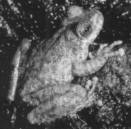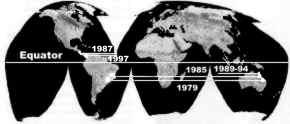Return To Frog Page

The CRC for Tropical Rainforest Ecology and Management Checking out frog declines with NASA The problem
The global declining frog problem was first identified at the First World Congress of Herpetology in 1989. Many scientists were initially sceptical, but they have since been convinced by data and now believe there is a serious problem.
About 10% (at least 27 species) of Australian frogs are endangered or threatened. This is almost certainly an underestimate because they are hard to count and because many species occur in remote areas; many have never been effectively counted. Frogs are obvious when in people's houses (only a few common species do this), and when they are calling and breeding (which they only do for a small part of the year), but are very secretive and hidden most of the time. Threats to frogs
The threats to many frog populations have been identified: many are caused by human activities such as land clearance, habitat loss, habitat degradation, and pesticide or herbicide use.
However, the causes of declines in some frog populations in subtropical and tropical Australia, Brazil, and Central America remain a mystery. All of these frog populations occur in high-elevation rainforests that did not experience obvious adverse human impacts at the times when the frogs declined.
The 10 declining Australian frog species include the majority of our native rainforest species. All of these species breed in streams in higher-elevation rainforests.
Rainforest CRC researchers were intensively monitoring populations at two sites in the wet tropics as they declined.
Adult frogs crashed from normal numbers to complete disappearance within 2-3 months. Tadpoles remained in streams until they transformed into froglets, then disappeared and did not return.

Nyctimystes dayi, one of the species that has declined everywhere it occurs above 400 metres elevation in north Queensland, but still found at lowland sites.
Disease or climate change?
Recently, a fungal disease has been identified which may have killed frogs in some populations. It is possible that this disease is solely responsible for the mysterious tropical frog declines, but there are many reasons why it may not be. Scientists are working on determining what role this disease has played, and what factors may have caused the outbreak.
There is good evidence from measurements of the body condition of frogs that their condition began to deteriorate long before populations disappeared.
This suggests that a disease was not the sole cause of the disappearances of species, as it would seem unlikely that a disease could cause declining body condition for years, then suddenly kill off all terrestrial frogs simultaneously.
The slow decline in body condition of frogs may have been caused by changes in weather or climate: frogs are very sensitive to water, and have very permeable skins. Inadequate dry-season rainfall has been singly common in many tropical rainforests in recent years, and is likely to cause stress which affects frogs' body condition and may suppress their immune systems.
Changes in wind speed and direction might carry environmental contaminants from agriculture or industry into apparently remote rainforest habitats. Alterations in the level of clouds and amount of mist might allow contaminants concentrated on water droplets to make contact with the permeable skins of frogs.
NASA looks for links with climate change
An international group of frog researchers working in Australia, North America, Central and South America, and Europe, are collaborating with the US space agency NASA and other climate researchers to look for correlations between global climate and weather patterns and frog declines.

Litoria nonnotis,
another species which has declined everywhere it occurs
above 400 metres elevation in north Queensland,
but still found at lowland sites
This group has identified what appear to be patterns in frog declines: in the Southern Hemisphere, declines started in the subtropics in the late 1970s and moved northward into the tropics in the 1980s and early 1990s (see map).
This occurred in southeastern Brazil and eastern Australia, affecting species living at high elevations in coastal mountain ranges and breeding in streams.
Mysterious subtropical and tropical frog declines

Photo courtesy of ESA/ESRIN The lines on the map mark the places where frogs declined in coastal mountain ranges in the subtropics and tropics during 1979 - 1997. Declines occurred at very similar times and latitudes in eastern Australia and Brazil in 1979 and 1985. Later declines in northern Australia were not paralleled in Brazil, probably because there are no coastal mountain ranges at that latitude in Brazil.
The declines in Central America are also progressing towards the Equator, from the opposite direction. Unfortunately, at present we do not have any data from Madagascar or south eastern or north eastern Africa, the other places where parallel declines might have occurred.
Researchers are now searching for data from similar habitats in Africa and Madagascar. In the 1980s and continuing to the present, a similar sequence of declines has occurred in tropical Central America, moving towards the equator from the north (see map).
NASA will provide researchers with data from satellite remote sensing that will look at whether changes in patterns of temperature, humidity, precipitation, evaporation, cloud cover, or cloud level occurred at the same times and places as the "mysterious" frog declines.
Return To Frog Page For more information Contact: Associate Professor Ross Alford
Zoology and Tropical Ecology
James Cook University
Townsville, Queensland
Australia 4811
Phone: 07 47814732
Fax: 07 4725 1570
Ernail: ross.alford@jcu.edu.au |  |
The CRC for Tropical Rainforest Ecology and Management is a formal partnership between the CSIRO, James Cook University of North Queensland, The University of Queensland, Griffith University and the Wet Tropics Management Authority.
P 0 Box 6811 Cairns Qld 4870 tel: (07) 4042 1246 fax : (07) 4042 1247
Web site: http://www.crctrem.edu.au Providing science for the conservation and management of Australia's World Heritage tropical rainforests. 
Return To Frog Page
| 